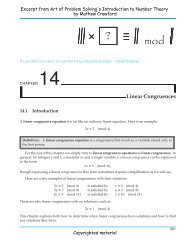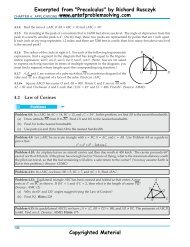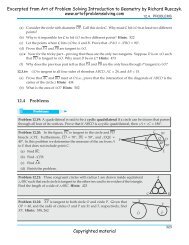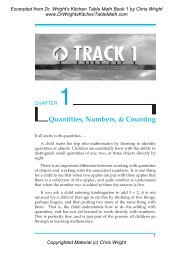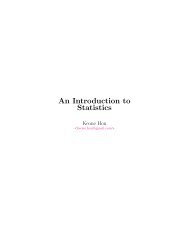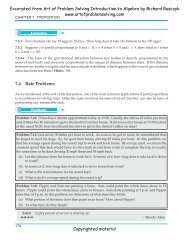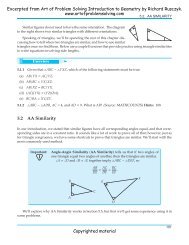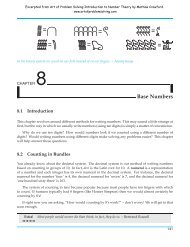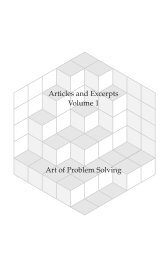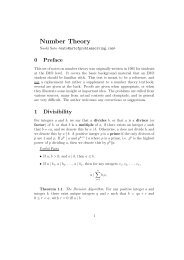Kitchen Table Math Book 1 (ver 2) - Art of Problem Solving
Kitchen Table Math Book 1 (ver 2) - Art of Problem Solving
Kitchen Table Math Book 1 (ver 2) - Art of Problem Solving
Create successful ePaper yourself
Turn your PDF publications into a flip-book with our unique Google optimized e-Paper software.
Excerpted from Dr. Wright's <strong>Kitchen</strong> <strong>Table</strong> <strong>Math</strong> <strong>Book</strong> 1 by Chris Wright<br />
www.DrWrights<strong>Kitchen</strong><strong>Table</strong><strong>Math</strong>.com<br />
CHAPTER 11. TIME<br />
11.2 Clock face reading<br />
Reading the time from a clock face.<br />
Areas <strong>of</strong> confusion There are a couple <strong>of</strong> typical areas <strong>of</strong> confusion.<br />
The first is remembering which hand is the minute hand and<br />
which is the hour hand. Another is figuring out which hour the<br />
hour hand is pointing to. A third problem is learning that the<br />
clock face numbers are not only used to indicate the hour, but<br />
also, somewhat cryptically, the minutes.<br />
Establish early and <strong>of</strong>ten that the hour hand is the shorter <strong>of</strong><br />
the two hands, and the minute hand is the longer <strong>of</strong> the two<br />
hands. There generally is little additional confusion if the clock<br />
happens to have a second hand, because the second hand moves<br />
so quickly compared to the others.<br />
Teaching clocks Most educational supply stores sell clock faces that<br />
have hands that are easy to move around to whate<strong>ver</strong> time you<br />
want to talk about. You can, <strong>of</strong> course, just use any wall clock<br />
or similar clock, but the hands are usually much harder to move<br />
around, and they are also easier to break.<br />
166<br />
You can also simply draw pictures <strong>of</strong> clock faces with various<br />
times on them, or get math work books that have pages <strong>of</strong><br />
questions about telling time.<br />
Copyrighted Material (c) Chris Wright
Excerpted from Dr. Wright's <strong>Kitchen</strong> <strong>Table</strong> <strong>Math</strong> <strong>Book</strong> 1 by Chris Wright<br />
www.DrWrights<strong>Kitchen</strong><strong>Table</strong><strong>Math</strong>.com<br />
11.2. CLOCK FACE READING<br />
Four steps Reading the time from a clock face occurs in four steps.<br />
1. Read the time exactly on the hour.<br />
2. Read quarter hours and half hours<br />
3. Read with minutes that are a multiple <strong>of</strong> five<br />
4. Read all times<br />
During these steps be sure to teach each skill in two ways – by<br />
showing a clock face and asking what time it shows, and by<br />
giving a time and asking your child to set the clock hands to<br />
show that time.<br />
Step 1 Read the time exactly on the hour.<br />
Start by telling time for exact hours where the minute hand is<br />
pointing at the 12. Do lots <strong>of</strong> examples, especially some with 12<br />
o’clock, where the hour hand is also pointing at the 12.<br />
9<br />
11<br />
10<br />
8<br />
7<br />
12<br />
6<br />
2:00<br />
1<br />
5<br />
2<br />
4<br />
3<br />
9<br />
11<br />
10<br />
8<br />
7<br />
12<br />
6<br />
6:00<br />
Step 2 Read quarter hours and half hours.<br />
1<br />
5<br />
2<br />
4<br />
3<br />
9<br />
11<br />
10<br />
8<br />
7<br />
12<br />
6<br />
11:00<br />
Usually children quickly learn that the minute hand pointing at<br />
the 3 means quarter past, pointing at the 6 means half past, and<br />
pointing at the 9 means quarter till.<br />
What is <strong>of</strong>ten difficult for children is deciding which hour it is<br />
when the hour hand is not pointing straight at one number.<br />
Approach this by first teaching your child the direction, “clockwise,”<br />
<strong>of</strong> hand movement around a clock. The hands move from<br />
a number to the next bigger number (except when moving from<br />
12 to 1).<br />
After your child is confident with clockwise movement, then,<br />
when the hour hand is not pointing directly at a number, you can<br />
ask which number the hour hand is leaving, or which number<br />
was the last one it pointed at. This will tell your child the hour.<br />
Copyrighted Material (c) Chris Wright<br />
1<br />
5<br />
2<br />
4<br />
3<br />
167
Excerpted from Dr. Wright's <strong>Kitchen</strong> <strong>Table</strong> <strong>Math</strong> <strong>Book</strong> 1 by Chris Wright<br />
www.DrWrights<strong>Kitchen</strong><strong>Table</strong><strong>Math</strong>.com<br />
CHAPTER 11. TIME<br />
9<br />
11<br />
10<br />
8<br />
7<br />
12<br />
6<br />
1:15<br />
1<br />
5<br />
2<br />
4<br />
3<br />
9<br />
11<br />
10<br />
8<br />
7<br />
12<br />
6<br />
3:30<br />
1<br />
5<br />
2<br />
4<br />
3<br />
9<br />
11<br />
10<br />
8<br />
7<br />
12<br />
6<br />
7:45<br />
As your child gets comfortable with this step, start referring<br />
to these times sometimes in terms <strong>of</strong> 15, 30, or 45 minutes. For<br />
example, mention that a quarter past three can also be described<br />
as 15 minutes past three.<br />
Step 3 Read the minutes that are a multiple <strong>of</strong> five.<br />
168<br />
To do this step your child needs to either be able to do multiplication<br />
by 5 (Section 4.7), or skip count by 5 (Section 4.5).<br />
If your child is using skip counting, then there are two strategies<br />
that can be used. The more straight-forward approach for skip<br />
counting is to always skip count by 5’s around the clock until<br />
reaching where the minute hand is pointing.<br />
The second approach is to use knowledge <strong>of</strong> the values for 15, 30,<br />
and 45 minutes from the quarter and half hours. For example, if<br />
the minute hand is pointing at the 8, your child can start at the<br />
6 and say “30, 35, 40” and get to 40 much more quickly.<br />
9<br />
11<br />
10<br />
8<br />
7<br />
12<br />
6<br />
6:25<br />
1<br />
5<br />
5<br />
2<br />
4<br />
3<br />
25<br />
10<br />
20<br />
15<br />
40<br />
9<br />
11<br />
10<br />
8<br />
35<br />
7<br />
12<br />
6<br />
30<br />
2:40<br />
The practice in this step is great for working on skip counting<br />
and multiplying by 5. Similarly, if you take a time such as 3:40<br />
and ask your child to position the hands <strong>of</strong> the clock, this is<br />
excellent practice for Section 5.5: Dividing by 10 and 5 in the<br />
Dividing Chapter.<br />
Copyrighted Material (c) Chris Wright<br />
1<br />
5<br />
2<br />
4<br />
3<br />
1<br />
5<br />
2<br />
4<br />
3
Excerpted from Dr. Wright's <strong>Kitchen</strong> <strong>Table</strong> <strong>Math</strong> <strong>Book</strong> 1 by Chris Wright<br />
www.DrWrights<strong>Kitchen</strong><strong>Table</strong><strong>Math</strong>.com<br />
Step 4 Read all times.<br />
11.2. CLOCK FACE READING<br />
For this step you will need a clock that has tick marks for all <strong>of</strong><br />
the minutes.<br />
The method for figuring out how many minutes it is past the<br />
hour is to know how many minutes it is to the last multiple <strong>of</strong><br />
five, and then add on the additional minutes. For example, to<br />
read 3:42 on the clock face, your child would start at the 8 on<br />
the clock face and say “40,” and then add the additional two<br />
minutes to get 42.<br />
As before, there may be occasional confusion about which hour<br />
it is. Follow the directions given in step 2 for understanding<br />
which hour the hour hand most recently pointed to.<br />
After getting comfortable and practiced with telling how many<br />
minutes it is after the hour, have your child practice describing<br />
some <strong>of</strong> the times as a certain number <strong>of</strong> minutes before the next<br />
hour. For example, 3:42 can also be described as “18 minutes<br />
before 4.”<br />
Giving the number <strong>of</strong> minutes before the hour is not usually<br />
done by subtracting from 60, though it can be done that way.<br />
Usually, the child will count by 5’s backward from the 12 on<br />
the clock, and then add the few extra minutes as needed. For<br />
example, for 3:42 the child would count back “5, 10, 15” and<br />
then add 3 more to get to the 42 minute mark.<br />
42<br />
40<br />
9<br />
11<br />
10<br />
8<br />
35<br />
7<br />
12<br />
6<br />
30<br />
1<br />
5<br />
5<br />
2<br />
4<br />
3<br />
25<br />
42 after 3<br />
10<br />
20<br />
15<br />
9<br />
11<br />
10<br />
Copyrighted Material (c) Chris Wright<br />
15<br />
18<br />
10<br />
5<br />
8<br />
7<br />
12<br />
6<br />
1<br />
5<br />
2<br />
4<br />
3<br />
18 before 4<br />
169



